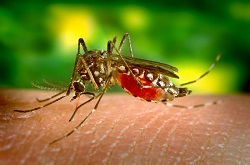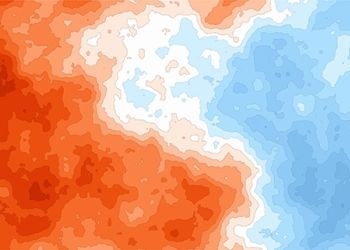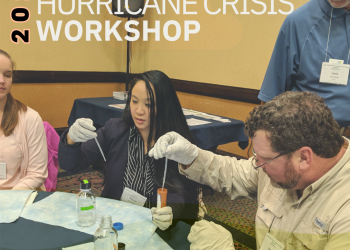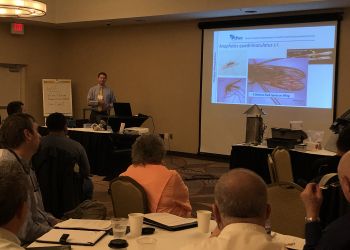By Sandra L. Fisher-Grainger, MPH, Director, Hernando County Mosquito Control
 With the introduction of Zika to the United States in 2016 in both people and local mosquitoes, vector-borne diseases have become more of a concern, especially when coupled with the possibility of known diseases spreading into new areas and the arrival of new diseases.
With the introduction of Zika to the United States in 2016 in both people and local mosquitoes, vector-borne diseases have become more of a concern, especially when coupled with the possibility of known diseases spreading into new areas and the arrival of new diseases.
Surveillance is possibly the most important element of an integrated mosquito management (IMM) program for disease surveillance and control decisions. For any organization seeking to start a mosquito surveillance program, there are several things to consider, from determining your target (life stage, season) to the specific tools you use.
Before you start, you must collect information and become knowledgeable about the ecology, geography, population, and climatic conditions in your area. Trapping and sampling surveillance should follow data collection and record keeping. Where are your at-risk populations located? Has there been disease in your area before and if so, where? Collecting this data will give you invaluable insight to drive surveillance decisions, and much of it is readily available through your local city or county government’s geographic information systems (GIS) department or possibly within your own organization. Even if this information is unavailable locally, there are federal and state organizations that can provide this information freely. In turn, the data you collect through surveillance should drive control decisions if this is part of your program.
A thoroughly equipped mosquito control program will include all the elements of IMM, which are control, surveillance, source reduction, and public outreach. Surveillance can be used to address issues identified in each of the other three areas. Surveillance of mosquito eggs, larvae and/or adults can identify vector species and guide control decisions and sample population numbers of vectors and nuisance species. It may inform source reduction in areas where it is needed (like dumped tires) and help determine what populations or areas within your jurisdiction need an outreach program. However, regardless of your organization’s capabilities, you doesn’t necessarily need all these components to conduct surveillance in a meaningful way.
Your target, why you are conducting surveillance, may only concern disease surveillance. Depending on your locality, this may include mosquitoes that cause encephalitis such as eastern equine encephalitis or the “fever” diseases like dengue or Zika. It is important to note that most vector-borne diseases do not share the same vector, so it is vital to have the person identifying mosquitoes be thoroughly trained. This can be achieved through a mosquito district or one of the many identification classes offered throughout the country each fall through spring. This training should additionally include instruction on the tools to conduct surveillance based on your target and the life cycle of the mosquito you wish to observe from eggs to adults.
If disease surveillance is your primary focus, you’ll be surveying for those species that are the vectors of your disease of concern. For Zika, dengue and chikungunya, these will include Aedes aegypti, the yellow fever mosquito, and possibly Aedes albopictus, the Asian tiger mosquito. Both of these are considered peridomestic mosquitoes that breed in tires and containers. In addition to being important disease vectors, these mosquitoes can cause nuisance issues in more urban and suburban areas.
Surveillance of the encephalitis viruses will include floodwater species and more specific habitat species as listed below.
Eastern equine encephalitis:
• Culiseta melanura, the black-tailed mosquito – found in acid swamps
• Coquillettidia perturbans, the Cattail mosquito – larvae attach to cattails
• Aedes vexans, the inland floodwater mosquito – found in floodwaters
West Nile virus:
• Culex nigripalpus, the Florida SLE mosquito – found in floodwaters
• Culex pipiens, the common or northern house mosquito – container and storm structure breeder
• Culex tarsalis, the western encephalitis mosquito – found in standing or semi-permanent waters
Knowing the species will help you to determine where your surveillance will be conducted prior to starting. This is why data collection and record keeping are critically important. Prior to starting surveillance, you should gather as much information as you can about your locality.
Through any GIS department you have access to, you can obtain maps that identify habitats by type; contour maps that can indicate low-lying areas; maps of all stormwater structures such as catch basins and storm drains; maps of agricultural fields; maps showing areas with the potential for flooding along lakes and rivers; as well as maps of freshwater or saltwater wetlands and swamps. Knowing this information in advance will be of assistance when planning where you’ll be conducting surveillance. If you do not have access to a GIS department, you can still obtain much of this data from federal government sites like the United States Geological Survey, the National Oceanographic and Atmospheric Administration, the United States Fish and Wildlife Service, and similar state sites.
An important note to mention is weather, which is extremely important to monitor, as mosquito breeding depends on rainfall, whether in containers or flooded areas. Some websites such as Weather Underground accept reports of public and private weather stations. Weather conditions may vary in different areas across your jurisdiction, so it is essential to have access to this data.
There is a wealth of information out there on starting a surveillance program. Several states, mosquito control associations and mosquito control districts have published or made available free handbooks, white papers, and similar articles to guide you in your surveillance efforts. A good place to start is the American Mosquito Control Association website, which has links to a plethora of information. Also, visit NACCHO’s vector control webpage, Vector Summit website, and Toolbox for event resources, webinar recordings, reports, tools, and more.






